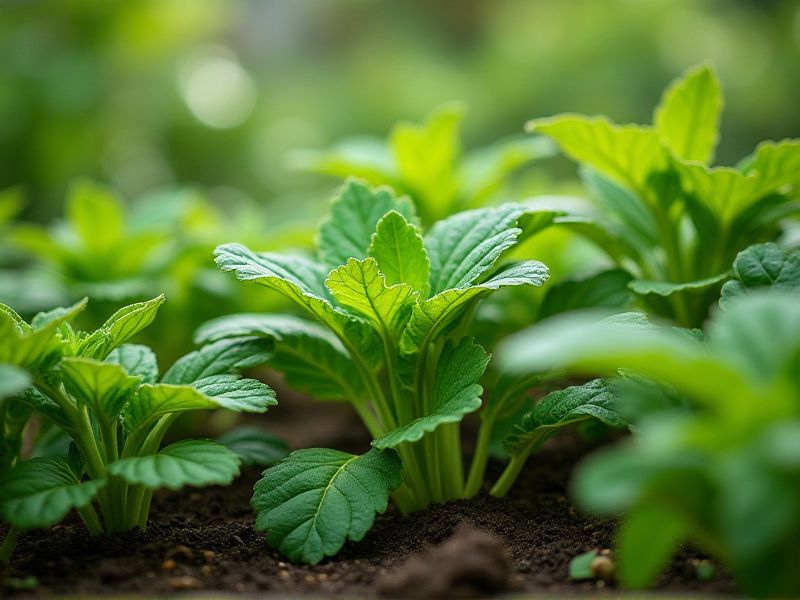
In small spaces, consider growing high-yield plants like cherry tomatoes, radishes, and herbs such as basil and cilantro, which thrive in containers. Vertical gardening techniques can maximize your limited area; use wall planters or trellises for climbing plants like peas and cucumbers. Hydroponic systems provide another space-efficient method, allowing you to cultivate leafy greens and strawberries without soil. Incorporate companion planting to enhance growth and deter pests, ensuring your small garden flourishes. Regularly harvesting encourages continuous growth, making the most out of your compact gardening space.
List of some Small-space plants that maximize yield
- Radish (Raphanus sativus)
- Spinach (Spinacia oleracea)
- Lettuce (Lactuca sativa)
- Chard (Beta vulgaris subsp. vulgaris)
- Bok Choy (Brassica rapa subsp. chinensis)
- Carrot (Daucus carota subsp. sativus)
- Green Onion (Allium fistulosum)
- Beetroot (Beta vulgaris subsp. vulgaris)
- Basil (Ocimum basilicum)
- Arugula (Eruca vesicaria)
Important things about Small-space plants that maximize yield
Light Requirements
Small-space plants, such as microgreens and dwarf varieties of vegetables, thrive best in bright, indirect light, ensuring they receive at least 12 to 16 hours of light daily for optimal growth. For indoor gardens, utilizing LED grow lights can significantly enhance yields by providing the necessary spectrum of light that mimics natural sunlight, promoting robust photosynthesis. Positioning plants near south-facing windows can also enhance their exposure to natural light, especially during winter months when daylight is limited. Proper light conditions not only maximize yields but also improve the flavor and nutrient density of your harvest.
Soil Quality
Improving soil quality is crucial when cultivating small-space plants to maximize yield. Utilizing organic matter such as compost enriches the soil, enhancing its fertility and structure, allowing for better water retention and aeration. Implementing techniques like crop rotation and companion planting can further boost nutrient availability while reducing pests naturally. To optimize growth, regularly testing soil pH and adjusting it to the ideal range for your specific plants is essential for achieving the best results.
Container Size
Selecting the right container size is crucial for maximizing yield in small-space plants such as herbs, dwarf vegetables, or compact flowering varieties. A container in the range of 5 to 10 gallons is ideal for most small-space crops, allowing for sufficient root development while making efficient use of limited space. Utilizing vertical gardening techniques or stacked planters can further optimize your growing area, enabling you to cultivate multiple plants in a confined footprint. To enhance drainage and soil aeration, consider containers with adequate drainage holes and incorporate soil amendments like perlite or vermiculite for healthier plant growth.
Vertical Gardening
Vertical gardening effectively utilizes limited space by allowing you to grow a variety of small-space plants that maximize yield. Consider herbs like basil, parsley, and mint, which thrive in vertical setups and offer high culinary value. Leafy greens such as spinach and lettuce not only grow well in compact arrangements but also produce multiple harvests throughout their growing season. Utilizing trellises for climbing vegetables like peas and cucumbers can further optimize your vertical garden, providing bountiful yields from minimal ground space.
Companion Planting
Companion planting in small spaces can significantly maximize yield by strategically pairing plants that benefit each other's growth. For instance, the classic combination of tomatoes and basil not only enhances flavor but also deters pests, creating a healthier growing environment. Incorporating vertical gardening techniques allows you to grow climbing plants like peas alongside low-growing lettuce, optimizing vertical space while boosting your harvest. By selecting compatible plants such as carrots and onions, you can enhance nutrient uptake and minimize competition, ultimately creating a productive garden even in limited areas.
Watering Needs
Small-space plants require careful attention to watering needs to maximize yield and ensure healthy growth. Plants like microgreens and herbs often thrive in well-draining containers, where consistent moisture is crucial for their development. You should monitor soil moisture closely, as container plants can dry out quickly, especially in warm environments. Implementing a watering schedule, or using self-watering pots, can help maintain an optimal balance of hydration, enhancing your overall gardening success.
Fertilization
Small-space gardening allows you to cultivate high-yield plants like cherry tomatoes, radishes, and herbs in limited areas. Utilizing vertical gardening techniques can significantly enhance your harvest by optimizing sunlight exposure and air circulation, making it ideal for urban settings. Implementing organic fertilizers, such as compost or worm castings, boosts soil nutrients, promoting healthier plants and larger yields. Selectively interplanting compatible species can further maximize your space and create a more productive garden environment.
Plant Variety
Small-space gardening can be incredibly rewarding, enabling you to grow a variety of plants that maximize yield in limited areas. Consider using compact varieties of vegetables such as cherry tomatoes, bush beans, and dwarf peppers, which thrive in containers or vertical gardens. Herbs like basil, parsley, and chives are perfect for small spaces and not only add flavor to your meals but also attract pollinators. By implementing square-foot gardening techniques, you can optimize plant placement and boost productivity, ensuring your small garden space is as efficient as possible.
Pest Management
Effective pest management for small-space plants is crucial to maximizing your yield and maintaining plant health. Implementing integrated pest management (IPM) techniques can help you identify and manage pests while minimizing chemical use. Companion planting, where you grow mutually beneficial plants alongside each other, can naturally deter harmful insects and promote growth. Regular monitoring, combined with organic pest control options such as neem oil or insecticidal soap, ensures your small garden thrives despite pest pressures.
Seasonal Rotation
Implementing seasonal rotation with small-space plants can significantly enhance your yield in urban gardening. Consider incorporating crops like lettuce, spinach, and radishes during cooler months, as they thrive in tighter spaces and mature quickly. In warmer seasons, switch to heat-tolerant plants like cherry tomatoes and compact peppers that offer high productivity without overwhelming your limited area. By carefully planning your planting schedule, you can ensure continuous harvests and optimal usage of available sunlight and nutrients throughout the year.
